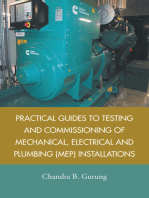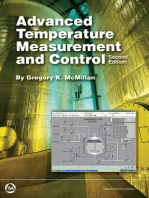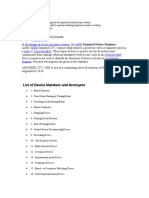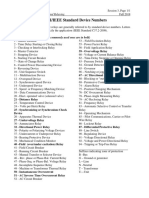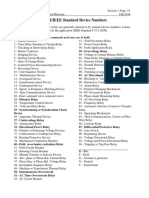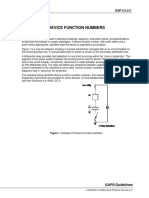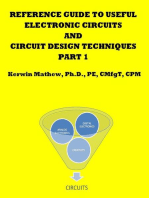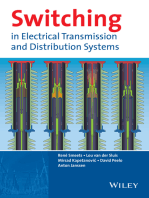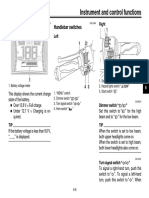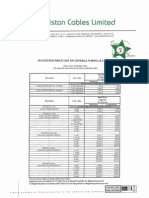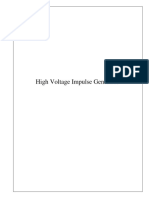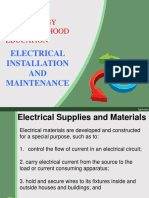0 ratings0% found this document useful (0 votes)
25 viewsANSI Device Numbers
ANSI Device Numbers
Uploaded by
sajjad200537ANSI device numbers denote the features that protective devices like relays and circuit breakers support to protect electrical systems. There are 99 standard device numbers that represent different protective functions. Device numbers may have suffixes to indicate things like connection to a neutral wire or to distinguish between multiple devices of the same type. Understanding ANSI device numbers is important for engineers working with power generation, transmission, and distribution systems to safely control and protect equipment and users.
Copyright:
© All Rights Reserved
Available Formats
Download as DOCX, PDF, TXT or read online from Scribd
ANSI Device Numbers
ANSI Device Numbers
Uploaded by
sajjad2005370 ratings0% found this document useful (0 votes)
25 views4 pagesANSI device numbers denote the features that protective devices like relays and circuit breakers support to protect electrical systems. There are 99 standard device numbers that represent different protective functions. Device numbers may have suffixes to indicate things like connection to a neutral wire or to distinguish between multiple devices of the same type. Understanding ANSI device numbers is important for engineers working with power generation, transmission, and distribution systems to safely control and protect equipment and users.
Copyright
© © All Rights Reserved
Available Formats
DOCX, PDF, TXT or read online from Scribd
Share this document
Did you find this document useful?
Is this content inappropriate?
ANSI device numbers denote the features that protective devices like relays and circuit breakers support to protect electrical systems. There are 99 standard device numbers that represent different protective functions. Device numbers may have suffixes to indicate things like connection to a neutral wire or to distinguish between multiple devices of the same type. Understanding ANSI device numbers is important for engineers working with power generation, transmission, and distribution systems to safely control and protect equipment and users.
Copyright:
© All Rights Reserved
Available Formats
Download as DOCX, PDF, TXT or read online from Scribd
Download as docx, pdf, or txt
0 ratings0% found this document useful (0 votes)
25 views4 pagesANSI Device Numbers
ANSI Device Numbers
Uploaded by
sajjad200537ANSI device numbers denote the features that protective devices like relays and circuit breakers support to protect electrical systems. There are 99 standard device numbers that represent different protective functions. Device numbers may have suffixes to indicate things like connection to a neutral wire or to distinguish between multiple devices of the same type. Understanding ANSI device numbers is important for engineers working with power generation, transmission, and distribution systems to safely control and protect equipment and users.
Copyright:
© All Rights Reserved
Available Formats
Download as DOCX, PDF, TXT or read online from Scribd
Download as docx, pdf, or txt
You are on page 1of 4
ANSI Device Numbers
From Wikipedia, the free encyclopedia
The
ANSI Standard Device Numbers
[1]
[2]
[3]
denote what features a protective device supports (such as a
relay or circuit breaker). These types of devices protect electrical systems and
components from damage when
an unwanted event occurs, such as an electrical fault.
List of Device Numbers
1 - Master Element
2 - Time Delay Starting or Closing Relay
3 - Checking or Interlocking Relay
4 - Master Contactor
5 - Stopping Device
6 - Starting Circuit Breaker
7 - Anode Circuit Breaker
8 - Control Power Disconnecting Device
9 - Reversing Device
10 - Unit Sequence Switch
11 -
Reserved for future application
12 - Overspeed Device
13 - Synchronous-speed Device
14 - Underspeed Device
15 - Speed - or Frequency, Matching Device
16 - Reserved for future application
17 - Shunting or Discharge Switch
18 - Accelerating or Decelerating Device
19 - Starting to Running Transition Contactor
20 - Electrically Operated Valve
21 - Distance Relay
22 - Equalizer Circuit Breaker
23 - Temperature Control Device
24 - Over-Excitation Relay (V/Hz)
25 - Synchronizing or Synchronism-Check
Device
26 - Apparatus Thermal Device
27 - Undervoltage Relay
28 - Flame Detector
29 - Isolating Contactor
30 - Annunciator Relay
31 - Separate Excitation Device
32 - Directional Power Relay
33 - Position Switch
34 - Master Sequence Device
35 - Brush-Operating or Slip-Ring Short-
Circuiting, Device
36 - Polarity or Polarizing Voltage Devices
37 - Undercurrent or Underpower Relay
38 - Bearing Protective Device
39 - Mechanical Conduction Monitor
40 - Field Relay
41 - Field Circuit Breaker
42 - Running Circuit Breaker
43 - Manual Transfer or Selector Device
44 - Unit Sequence Starting Relay
45 - Atmospheric Condition Monitor
46 - Reverse-phase or Phase-Balance Current
Relay
47 - Phase-Sequence Voltage Relay
48 - Incomplete Sequence Relay
49 - Machine or Transformer, Thermal Relay
50 - Instantaneous Overcurrent or Rate of Rise,
Relay
51 - AC Time Overcurrent Relay
52 - AC Circuit Breaker
53 - Exciter or DC Generator Relay
54 - High-Speed DC Circuit Breaker
55 - Power Factor Relay
56 - Field Application Relay
57 - Short-Circuiting or Grounding (Earthing)
Device
58 - Rectification Failure Relay
59 - Overvoltage Relay
60 - Voltage or Current Balance Relay
61 - Machine Split Phase Current Balance
62 - Time-Delay Stopping or Opening Relay
63 - Pressure Switch
64 - Ground (Earth) Detector Relay
65 - Governor
66 - Notching or Jogging Device
67 - AC Directional Overcurrent Relay
68 - Blocking Relay
69 - Permissive Control Device
70 - Rheostat
71 - Level Switch
72 - DC Circuit Breaker
73 - Load-Resistor Contactor
74 - Alarm Relay
75 - Position Changing Mechanism
76 - DC Overcurrent Relay
77 - Pulse Transmitter
78 - Phase-Angle Measuring or Out-of-Step
Protective Relay
79 - AC Reclosing Relay
80 - Flow Switch
81 - Frequency Relay
82 - DC Reclosing Relay
83 - Automatic Selective Control or Transfer
Relay
84 - Operating Mechanism
85 - Carrier or Pilot-Wire Receiver Relay
86 - Lockout Relay
87 - Differential Protective Relay
88 - Auxiliary Motor or Motor Generator
89 - Line Switch
90 - Regulating Device
91 - Voltage Directional Relay
92 - Voltage and Power Directional Relay
93 - Field Changing Contactor
94 - Tripping or Trip-Free Relay
95 - Reluctance Torque Synchrocheck
96 - Autoloading Relay
97 -
For specific applications where other
numbers are not suitable
98 -
For specific applications where other
numbers are not suitable
99 -
For specific applications where other
numbers are not suitable
N
ote 1: A suffix letter may be used with the device number; for example, suffix N is
used if the device is
connected to a Neutral wire (example: 59N in Siemens Relay is used for protection
against Neutral
Displacement); and suffixes X,Y,Z are used for auxiliary devices. Similarly, the
"G" suffix denotes a "gr
ound",
hence a "51G" being a time overcurrent ground relay
[4]
.
N
ote 2: A suffix number may also be used with a device number: numbers are used
to distinguish multiple
"same" devices in the same equipment such as 51-1, 51-2.
N
ote 3: Device numbers may be combined if the device provides multiple functions,
such as the
instantaneous/time-delay AC over current relay denoted as 50/51
N
ote 4: For function descriptions, refer to IEEE standards reference library or
American Standards C
37. For
understanding and learning application of these devices, many technical reference
books have been published
and are available. These device numbers and their application are typically in the
domain of electrical engineers,
specifically power generation, transmission or distribution system engineers in
regards to safely contro
lling and
p
rotecting users and equipment
You might also like
- MBC7X 652292Document18 pagesMBC7X 652292Gesiel SoaresNo ratings yet
- ANSI Device NumbersDocument3 pagesANSI Device NumbersSalman Ahmed MemonNo ratings yet
- Practical Guides to Testing and Commissioning of Mechanical, Electrical and Plumbing (Mep) InstallationsFrom EverandPractical Guides to Testing and Commissioning of Mechanical, Electrical and Plumbing (Mep) InstallationsRating: 4 out of 5 stars4/5 (4)
- Advanced Temperature Measurement and Control, Second EditionFrom EverandAdvanced Temperature Measurement and Control, Second EditionNo ratings yet
- Abc of Power Modules: Functionality, Structure and Handling of a Power ModuleFrom EverandAbc of Power Modules: Functionality, Structure and Handling of a Power ModuleNo ratings yet
- Effect of BLDC Motor Commutation Schemes On Inverter Capacitor Size SelectionDocument5 pagesEffect of BLDC Motor Commutation Schemes On Inverter Capacitor Size SelectionXristos LianNo ratings yet
- Ahf Maintenance GuidelinesDocument3 pagesAhf Maintenance GuidelinesSenthil Kumar100% (1)
- Ansi Code For Protective RelayDocument3 pagesAnsi Code For Protective RelayUNNI VENUGOPALNo ratings yet
- List of Device Numbers and AcronymsDocument7 pagesList of Device Numbers and AcronymsAnonymous IAKrngDaNo ratings yet
- Ansi Device NumbersDocument3 pagesAnsi Device NumbersAshley RequenezNo ratings yet
- A Listing of ANSI Device NumbersDocument7 pagesA Listing of ANSI Device NumbersOhaneje UzomaNo ratings yet
- ANSI Numbers For Protection DevicesDocument5 pagesANSI Numbers For Protection DevicesPrrashNo ratings yet
- Ansi 37.2Document4 pagesAnsi 37.2octofantemNo ratings yet
- Codigos ANSI PDFDocument3 pagesCodigos ANSI PDFjosleinyNo ratings yet
- Ansi CodesDocument3 pagesAnsi CodesMunavwar ProfessNo ratings yet
- ANSI Device NumberDocument5 pagesANSI Device NumberMarcos Andres Caceres AlmeidaNo ratings yet
- ANSI Device NumbersDocument4 pagesANSI Device NumbersBharath SaiNo ratings yet
- List of Device Numbers and AcronymsDocument22 pagesList of Device Numbers and AcronymsewbedonNo ratings yet
- ANSI Device NumbersDocument4 pagesANSI Device Numbersvraja76No ratings yet
- Ansi Code For Protective RelayDocument3 pagesAnsi Code For Protective RelayBayu Jatmiko Utomo100% (1)
- ANSI CODES For Protection DevicesDocument2 pagesANSI CODES For Protection DevicesHarpreet Singh BathNo ratings yet
- ANSI Device NumbersDocument4 pagesANSI Device NumbersAlexandru IoanNo ratings yet
- Relay Device NumbersDocument1 pageRelay Device Numbersuadikema01No ratings yet
- List of Device Numbers and AcronymsDocument7 pagesList of Device Numbers and AcronymsSharath Teja ReddyNo ratings yet
- List of Ansi Code For RelaysDocument3 pagesList of Ansi Code For RelaysFarahdinahNo ratings yet
- ANSI Device NumbersDocument3 pagesANSI Device NumbersMasrurul Azni Abdul AzizNo ratings yet
- ANSI Codes For Protection FunctionsDocument3 pagesANSI Codes For Protection FunctionsAmir Mahdavian100% (1)
- Coduri ANSIDocument2 pagesCoduri ANSIAnonymous 9rdcwejNo ratings yet
- ANSI Device Numbers - Wikipedia, The Free EncyclopediaDocument4 pagesANSI Device Numbers - Wikipedia, The Free EncyclopediaShadab WaseemNo ratings yet
- ANSI Numbers Protection and ControlDocument2 pagesANSI Numbers Protection and ControlEshwar MadiwalNo ratings yet
- Device Numbers and Acronyms As Per IEEE or ANSIDocument6 pagesDevice Numbers and Acronyms As Per IEEE or ANSIurkirannandaNo ratings yet
- Ieee - C37.2-2008Document1 pageIeee - C37.2-2008DANIEL3991No ratings yet
- ANSI Device Numbers PDFDocument1 pageANSI Device Numbers PDFPutra Kusuma HarditoNo ratings yet
- List of Device Numbers and Acronyms: Distance RelayDocument4 pagesList of Device Numbers and Acronyms: Distance Relayaloknayak1984No ratings yet
- Relayd 1Document1 pageRelayd 1amirtha_s2238No ratings yet
- Codigo Ansi de Funciones de ProteccionesDocument5 pagesCodigo Ansi de Funciones de ProteccionesGerman SchwabNo ratings yet
- ANSI Device Numbers - WikipDocument3 pagesANSI Device Numbers - WikipSandeep SaikiaNo ratings yet
- Protection Relay CodeDocument1 pageProtection Relay CodebenNo ratings yet
- Ansi CodeDocument3 pagesAnsi CodeRiza Ibn AdriansyahNo ratings yet
- IEEE Standard Device NumbersDocument1 pageIEEE Standard Device NumbersBA GomNo ratings yet
- ANSI Protection Codes - WikiDocument3 pagesANSI Protection Codes - WikiSatinderpal SinghNo ratings yet
- 06b - Relaying Fundamentals ANSI DEVICE CODES - r2Document2 pages06b - Relaying Fundamentals ANSI DEVICE CODES - r2Pool Martinez AlejandroNo ratings yet
- Device Function Numbers: GAP.5.0.2.CDocument8 pagesDevice Function Numbers: GAP.5.0.2.Cbakien-canNo ratings yet
- AnsiDocument2 pagesAnsiVellai Pandi PNo ratings yet
- CodesDocument3 pagesCodesVishnu Vardhan Reddy BaitintiNo ratings yet
- Reference Guide To Useful Electronic Circuits And Circuit Design Techniques - Part 2From EverandReference Guide To Useful Electronic Circuits And Circuit Design Techniques - Part 2No ratings yet
- Reference Guide To Useful Electronic Circuits And Circuit Design Techniques - Part 1From EverandReference Guide To Useful Electronic Circuits And Circuit Design Techniques - Part 1Rating: 2.5 out of 5 stars2.5/5 (3)
- Simulation of Some Power Electronics Case Studies in Matlab Simpowersystem BlocksetFrom EverandSimulation of Some Power Electronics Case Studies in Matlab Simpowersystem BlocksetNo ratings yet
- Simulation of Some Power Electronics Case Studies in Matlab Simpowersystem BlocksetFrom EverandSimulation of Some Power Electronics Case Studies in Matlab Simpowersystem BlocksetNo ratings yet
- Radio Control for Model Ships, Boats and AircraftFrom EverandRadio Control for Model Ships, Boats and AircraftRating: 5 out of 5 stars5/5 (1)
- Some Power Electronics Case Studies Using Matlab Simpowersystem BlocksetFrom EverandSome Power Electronics Case Studies Using Matlab Simpowersystem BlocksetNo ratings yet
- Simulation of Some Power System, Control System and Power Electronics Case Studies Using Matlab and PowerWorld SimulatorFrom EverandSimulation of Some Power System, Control System and Power Electronics Case Studies Using Matlab and PowerWorld SimulatorNo ratings yet
- Introduction to Power System ProtectionFrom EverandIntroduction to Power System ProtectionRating: 5 out of 5 stars5/5 (1)
- Influence of System Parameters Using Fuse Protection of Regenerative DC DrivesFrom EverandInfluence of System Parameters Using Fuse Protection of Regenerative DC DrivesNo ratings yet
- Analog Dialogue Volume 46, Number 1: Analog Dialogue, #5From EverandAnalog Dialogue Volume 46, Number 1: Analog Dialogue, #5Rating: 5 out of 5 stars5/5 (1)
- Arduino Measurements in Science: Advanced Techniques and Data ProjectsFrom EverandArduino Measurements in Science: Advanced Techniques and Data ProjectsNo ratings yet
- Ultrasound Analysis for Condition Monitoring: Applications of Ultrasound Detection for Various Industrial EquipmentFrom EverandUltrasound Analysis for Condition Monitoring: Applications of Ultrasound Detection for Various Industrial EquipmentRating: 4.5 out of 5 stars4.5/5 (3)
- 1.signoff Semi BlogDocument96 pages1.signoff Semi Blogannepaka mahendarNo ratings yet
- Sylvania CRT Data SheetsDocument306 pagesSylvania CRT Data SheetsPablo Angel bb ģii gzcu bxofjhdHolaNo ratings yet
- HV Outdoor Capacitor Voltage TransformersDocument6 pagesHV Outdoor Capacitor Voltage TransformersgdgdinNo ratings yet
- Ghungur NewDocument1 pageGhungur Newbedanta duttaNo ratings yet
- Manuel - Manual RPL23 Rev1.6 EngDocument10 pagesManuel - Manual RPL23 Rev1.6 EngMayur GuptaNo ratings yet
- Yamaha Nmax 155 - Battery Voltage DisplayDocument1 pageYamaha Nmax 155 - Battery Voltage Displaymotley crewzNo ratings yet
- DC-DC Converter To Step Up Input VoltageDocument3 pagesDC-DC Converter To Step Up Input VoltageFawwaaz HoseinNo ratings yet
- Substation 2Document26 pagesSubstation 2Jahirul QuaimNo ratings yet
- Lab2 Report 1620660042Document21 pagesLab2 Report 1620660042Nafiz SheikhNo ratings yet
- Experiment 5Document6 pagesExperiment 5chue_mei100% (1)
- Philippine Electrical Code #5Document116 pagesPhilippine Electrical Code #5Jeffrey AlimarioNo ratings yet
- Pakistan Cables Price ListDocument2 pagesPakistan Cables Price ListMudasarS91% (11)
- C0395a 002 (A)Document3 pagesC0395a 002 (A)M. FakNo ratings yet
- Devidry Pro Kit VLEDC102Document2 pagesDevidry Pro Kit VLEDC102Cesar Emiliano GeraceNo ratings yet
- Chapter 2 PDFDocument11 pagesChapter 2 PDFAmirNo ratings yet
- Reactive Power Management - Case Study: - Nandan Pathak (AE)Document20 pagesReactive Power Management - Case Study: - Nandan Pathak (AE)Devas ShuklaNo ratings yet
- Physics Homework 3Document1 pagePhysics Homework 3ChristianNo ratings yet
- Work 2 Electrical-MachineryDocument1 pageWork 2 Electrical-MachineryOmar AlvaradoNo ratings yet
- 13 PCB Diagram Circuit: Samsung Electronics 55Document3 pages13 PCB Diagram Circuit: Samsung Electronics 55Cory EnmanuelNo ratings yet
- Impulse GeneratorDocument10 pagesImpulse GeneratorUdaya PushpakumaraNo ratings yet
- WWW - Iscsemi.cn: Isc 2SA1441Document2 pagesWWW - Iscsemi.cn: Isc 2SA1441che-ahmad-majdi-7191No ratings yet
- Understand Electronic ComponentsDocument83 pagesUnderstand Electronic Componentsfuse125No ratings yet
- TQ - ABB-LV SWGRDocument4 pagesTQ - ABB-LV SWGRmalli55No ratings yet
- Unit 01 AssignmentDocument12 pagesUnit 01 Assignmentvipul unagarNo ratings yet
- Dry Type TR ManualDocument23 pagesDry Type TR Manualemy1188No ratings yet
- Electrical Installation and MaintenanceDocument85 pagesElectrical Installation and MaintenanceShane Puertollano92% (13)
- Debremarkos University: Institute of TechnologyDocument14 pagesDebremarkos University: Institute of TechnologyMinale Birlie100% (4)


